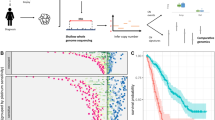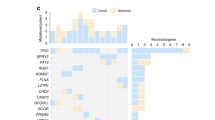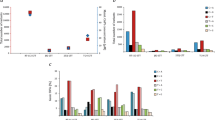Abstract
Resistance to chemotherapy in ovarian cancer is poorly understood. Evolutionary models of cancer predict that, following treatment, resistance emerges either because of outgrowth of an intrinsically resistant sub-clone or evolves in residual disease under the selective pressure of treatment. To investigate genetic evolution in high-grade serous (HGS) ovarian cancers, we first analysed cell line series derived from three cases of HGS carcinoma before and after platinum resistance had developed (PEO1, PEO4 and PEO6; PEA1 and PEA2; and PEO14 and PEO23). Analysis with 24-colour fluorescence in situ hybridisation and single nucleotide polymorphism (SNP) array comparative genomic hybridisation (CGH) showed mutually exclusive endoreduplication and loss of heterozygosity events in clones present at different time points in the same individual. This implies that platinum-sensitive and -resistant disease was not linearly related, but shared a common ancestor at an early stage of tumour development. Array CGH analysis of six paired pre- and post-neoadjuvant treatment HGS samples from the CTCR-OV01 clinical study did not show extensive copy number differences, suggesting that one clone was strongly dominant at presentation. These data show that cisplatin resistance in HGS carcinoma develops from pre-existing minor clones but that enrichment for these clones is not apparent during short-term chemotherapy treatment.
This is a preview of subscription content, access via your institution
Access options
Subscribe to this journal
Receive 50 print issues and online access
$259.00 per year
only $5.18 per issue
Buy this article
- Purchase on Springer Link
- Instant access to full article PDF
Prices may be subject to local taxes which are calculated during checkout



Similar content being viewed by others
Accession codes
References
Agarwal R, Kaye SB . (2003). Ovarian cancer: strategies for overcoming resistance to chemotherapy. Nat Rev Cancer 3: 502–516.
Ahmed AA, Etemadmoghadam D, Temple J, Lynch AG, Riad M, Sharma R et al. (2010). Driver mutations in TP53 are ubiquitous in high grade serous carcinoma of the ovary. J Pathol 221: 49–56.
Ahmed AA, Mills AD, Ibrahim AE, Temple J, Blenkiron C, Vias M et al. (2007). The extracellular matrix protein TGFBI induces microtubule stabilization and sensitizes ovarian cancers to paclitaxel. Cancer Cell 12: 514–527.
Alsop AE, Teschendorff AE, Edwards PA . (2006). Distribution of breakpoints on chromosome 18 in breast, colorectal, and pancreatic carcinoma cell lines. Cancer Genet Cytogenet 164: 97–109.
Bast Jr RC, Hennessy B, Mills GB . (2009). The biology of ovarian cancer: new opportunities for translation. Nat Rev Cancer 9: 415–428.
Bayani J, Brenton JD, Macgregor PF, Beheshti B, Albert M, Nallainathan D et al. (2002). Parallel analysis of sporadic primary ovarian carcinomas by spectral karyotyping, comparative genomic hybridization, and expression microarrays. Cancer Res 62: 3466–3476.
Bhattacharyya A, Ear US, Koller BH, Weichselbaum RR, Bishop DK . (2000). The breast cancer susceptibility gene BRCA1 is required for subnuclear assembly of Rad51 and survival following treatment with the DNA cross-linking agent cisplatin. J Biol Chem 275: 23899–23903.
Curto M, McClatchey AI . (2008). Nf2/Merlin: a coordinator of receptor signalling and intercellular contact. Br J Cancer 98: 256–262.
Etemadmoghadam D, deFazio A, Beroukhim R, Mermel C, George J, Getz G et al. (2009). Integrated genome-wide DNA copy number and expression analysis identifies distinct mechanisms of primary chemoresistance in ovarian carcinomas. Clin Cancer Res 15: 1417–1427.
Hanahan D, Weinberg RA . (2000). The hallmarks of cancer. Cell 100: 57–70.
Herzog TJ . (2004). Recurrent ovarian cancer: how important is it to treat to disease progression? Clin Cancer Res 10: 7439–7449.
Herzog TJ, Pothuri B . (2006). Ovarian cancer: a focus on management of recurrent disease. Nat Clin Pract Oncol 3: 604–611.
Hofmann WK, Komor M, Wassmann B, Jones LC, Gschaidmeier H, Hoelzer D et al. (2003). Presence of the BCR-ABL mutation Glu255Lys prior to STI571 (imatinib) treatment in patients with Ph+ acute lymphoblastic leukemia. Blood 102: 659–661.
Kamb A, Gruis NA, Weaver-Feldhaus J, Liu Q, Harshman K, Tavtigian SV et al. (1994). A cell cycle regulator potentially involved in genesis of many tumor types. Science 264: 436–440.
Kang Y, Siegel PM, Shu W, Drobnjak M, Kakonen SM, Cordon-Cardo C et al. (2003). A multigenic program mediating breast cancer metastasis to bone. Cancer Cell 3: 537–549.
Khalique L, Ayhan A, Weale ME, Jacobs IJ, Ramus SJ, Gayther SA . (2007). Genetic intra-tumour heterogeneity in epithelial ovarian cancer and its implications for molecular diagnosis of tumours. J Pathol 211: 286–295.
Kobel M, Huntsman D, Gilks CB . (2008). Critical molecular abnormalities in high-grade serous carcinoma of the ovary. Expert Rev Mol Med 10: e22.
Langdon SP, Lawrie SS, Hay FG, Hawkes MM, McDonald A, Hayward IP et al. (1988). Characterization and properties of nine human ovarian adenocarcinoma cell lines. Cancer Res 48: 6166–6172.
Liu W, Laitinen S, Khan S, Vihinen M, Kowalski J, Yu G et al. (2009). Copy number analysis indicates monoclonal origin of lethal metastatic prostate cancer. Nat Med 15: 559–565.
Markman M, Rothman R, Hakes T, Reichman B, Hoskins W, Rubin S et al. (1991). Second-line platinum therapy in patients with ovarian cancer previously treated with cisplatin. J Clin Oncol 9: 389–393.
McAlpine JN, Eisenkop SM, Spirtos NM . (2008). Tumor heterogeneity in ovarian cancer as demonstrated by in vitro chemoresistance assays. Gynecol Oncol 110: 360–364.
Merlo LM, Pepper JW, Reid BJ, Maley CC . (2006). Cancer as an evolutionary and ecological process. Nat Rev Cancer 6: 924–935.
Mullighan CG, Phillips LA, Su X, Ma J, Miller CB, Shurtleff SA et al. (2008). Genomic analysis of the clonal origins of relapsed acute lymphoblastic leukemia. Science 322: 1377–1380.
Nowell PC . (1976). The clonal evolution of tumor cell populations. Science 194: 23–28.
Ouellet V, Zietarska M, Portelance L, Lafontaine J, Madore J, Puiffe ML et al. (2008). Characterization of three new serous epithelial ovarian cancer cell lines. BMC Cancer 8: 152.
Paige AJ, Taylor KJ, Taylor C, Hillier SG, Farrington S, Scott D et al. (2001). WWOX: a candidate tumor suppressor gene involved in multiple tumor types. Proc Natl Acad Sci USA 98: 11417–11422.
Roschke AV, Stover K, Tonon G, Schaffer AA, Kirsch IR . (2002). Stable karyotypes in epithelial cancer cell lines despite high rates of ongoing structural and numerical chromosomal instability. Neoplasia 4: 19–31.
Ruijter ET, van de Kaa CA, Schalken JA, Debruyne FM, Ruiter DJ . (1996). Histological grade heterogeneity in multifocal prostate cancer. Biological and clinical implications. J Pathol 180: 295–299.
Sakai W, Swisher EM, Jacquemont C, Chandramohan KV, Couch FJ, Langdon SP et al. (2009). Functional restoration of BRCA2 protein by secondary BRCA2 mutations in BRCA2-mutated ovarian carcinoma. Cancer Res 69: 6381–6386.
Sakai W, Swisher EM, Karlan BY, Agarwal MK, Higgins J, Friedman C et al. (2008). Secondary mutations as a mechanism of cisplatin resistance in BRCA2-mutated cancers. Nature 451: 1116–1120.
Schulmann K, Mori Y, Croog V, Yin J, Olaru A, Sterian A et al. (2005). Molecular phenotype of inflammatory bowel disease-associated neoplasms with microsatellite instability. Gastroenterology 129: 74–85.
Shah SP, Morin RD, Khattra J, Prentice L, Pugh T, Burleigh A et al. (2009). Mutational evolution in a lobular breast tumour profiled at single nucleotide resolution. Nature 461: 809–813.
Shibata K, Mori M, Tanaka S, Kitano S, Akiyoshi T . (1998). Identification and cloning of human G-protein gamma 7, down-regulated in pancreatic cancer. Biochem Biophys Res Commun 246: 205–209.
Swanton C, Marani M, Pardo O, Warne PH, Kelly G, Sahai E et al. (2007). Regulators of mitotic arrest and ceramide metabolism are determinants of sensitivity to paclitaxel and other chemotherapeutic drugs. Cancer Cell 11: 498–512.
Swanton C, Nicke B, Schuett M, Eklund AC, Ng C, Li Q et al. (2009). Chromosomal instability determines taxane response. Proc Natl Acad Sci USA 106: 8671–8676.
Swisher EM, Sakai W, Karlan BY, Wurz K, Urban N, Taniguchi T . (2008). Secondary BRCA1 mutations in BRCA1-mutated ovarian carcinomas with platinum resistance. Cancer Res 68: 2581–2586.
Torres L, Ribeiro FR, Pandis N, Andersen JA, Heim S, Teixeira MR . (2007). Intratumor genomic heterogeneity in breast cancer with clonal divergence between primary carcinomas and lymph node metastases. Breast Cancer Res Treat 102: 143–155.
Toyoda M, Shirato H, Nakajima K, Kojima M, Takahashi M, Kubota M et al. (2003). Jumonji downregulates cardiac cell proliferation by repressing cyclin D1 expression. Dev Cell 5: 85–97.
Trofatter JA, MacCollin MM, Rutter JL, Murrell JR, Duyao MP, Parry DM et al. (1993). A novel moesin-, ezrin-, radixin-like gene is a candidate for the neurofibromatosis 2 tumor suppressor. Cell 75: 826.
Turner N, Tutt A, Ashworth A . (2004). Hallmarks of ′BRCAness′ in sporadic cancers. Nat Rev Cancer 4: 814–819.
Zhu YM, Foroni L, McQuaker IG, Papaioannou M, Haynes A, Russell HH . (1999). Mechanisms of relapse in acute leukaemia: involvement of p53 mutated subclones in disease progression in acute lymphoblastic leukaemia. Br J Cancer 79: 1151–1157.
Acknowledgements
We thank Paul Edwards for helpful discussion of the paper. We thank our patients and members of the Gynaecological Oncology Multidisciplinary Team at Cambridge University Hospitals NHS Foundation Trust for their participation in the CTCR-OV01 clinical study. This work was funded by Cancer Research UK. We acknowledge the support of the University of Cambridge, Hutchison Whampoa Ltd, the Cambridge Experimental Cancer Medicine Centre and the NIHR Biomedical Research Centre.
Author information
Authors and Affiliations
Corresponding author
Ethics declarations
Competing interests
The authors declare no conflict of interest.
Additional information
Supplementary Information accompanies the paper on the Oncogene website
Rights and permissions
About this article
Cite this article
Cooke, S., Ng, C., Melnyk, N. et al. Genomic analysis of genetic heterogeneity and evolution in high-grade serous ovarian carcinoma. Oncogene 29, 4905–4913 (2010). https://doi.org/10.1038/onc.2010.245
Received:
Revised:
Accepted:
Published:
Issue Date:
DOI: https://doi.org/10.1038/onc.2010.245
Keywords
This article is cited by
-
Evolutionary perspectives, heterogeneity and ovarian cancer: a complicated tale from past to present
Journal of Ovarian Research (2022)
-
Impact of neoadjuvant chemotherapy on somatic mutation status in high-grade serous ovarian carcinoma
Journal of Ovarian Research (2022)
-
A highly annotated database of genes associated with platinum resistance in cancer
Oncogene (2021)
-
Improving personalized tumor growth predictions using a Bayesian combination of mechanistic modeling and machine learning
Communications Medicine (2021)
-
The gold complex auranofin: new perspectives for cancer therapy
Discover Oncology (2021)



